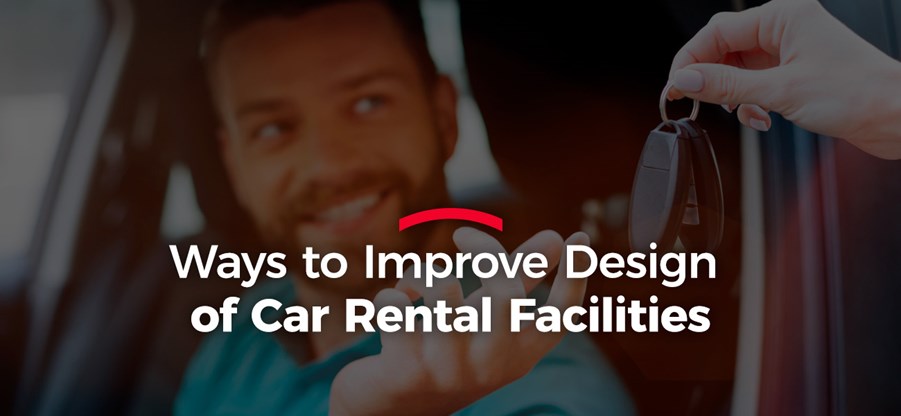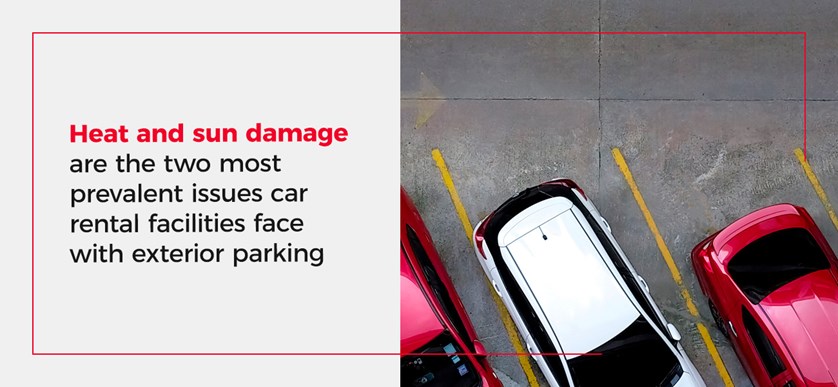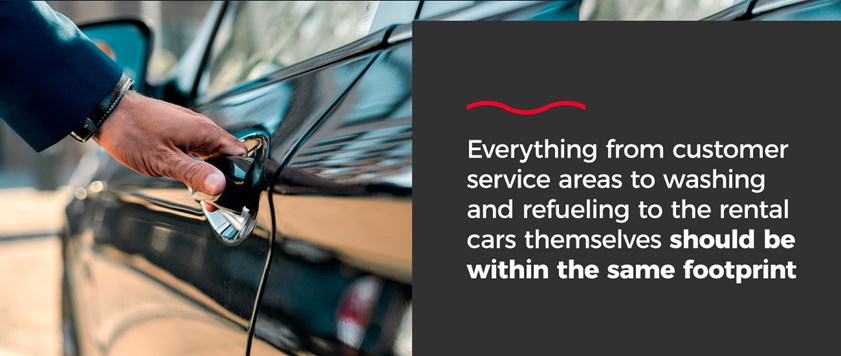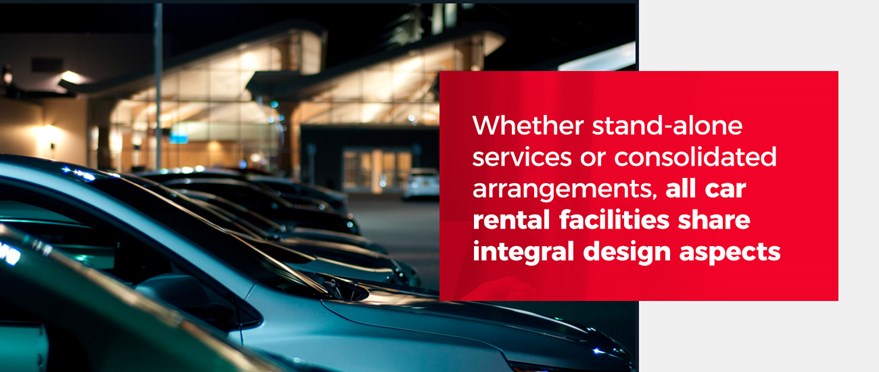Ways to Improve Design of Car Rental Facilities
02.11.22

Whether stand-alone services or consolidated arrangements, all car rental facilities share integral design aspects. However, discovering them and identifying their optimization potential is only one stage in the process. Improving the design requires understanding what the facility is, how it works, and what it can become. A design based on that knowledge can enhance efficiency and appeal to customer desires.
Read the full article or jump to a specific section:
- Importance of Car Rental Facility Design
- Steps to Design a Car Rental Facility
- Ways to Improve Overall Car Rental Facility Design
- Benefits of Shade Structures for Car Rental Facilities
- Browse VPS Shade Structures
You can improve the user experience and the overall design of our car rental facility with hail protection structures. Contact our team to learn more and get your project started!
Importance of Car Rental Facility Design
Before finding ways to improve car rental facilities' design, it's critical to understand the essential elements that make a design successful. These facilities must be self-contained with sufficient space for all required areas, and the design must appeal to all types of customers. If the facility will be a consolidated rent-a-car (ConRAC) service, it's also vital to consider balanced business dynamics.
The Facility Is Self-Contained
A successful car rental facility has all the tools and technology necessary to serve its customers, clean and maintain its fleet, and facilitate efficient pickups and returns.
Everything from customer service areas to washing and refueling to the rental cars themselves should be within the same footprint. The design should make it as easy and efficient for employees to move vehicles from one stage to another as it is for customers to pick up and return their rentals. A well-designed facility's different areas are close to each other, and the routes between them are clear and easily traversable.
The Facility Has Sufficient Space
For a facility to have everything it needs in a single centralized location, it must have adequate space to work with.
Compromising on space might mean giving one portion of the facility less than it needs to run smoothly and efficiently. A well-thought-out design maximizes what's available without shorting one area in favor of another. Nevertheless, it's vital to be aware of the facility's minimum spatial requirements during the design stage.
The Facility Has Customer Appeal
The facility design must appeal to the travelers using it.

The design must keep navigation, comfort, and accessibility at the forefront in all areas. Many car rental customers have already spent a portion of their day traveling and want the facility to anticipate that. Design should prioritize appeal on a visual and user level. It should consider walking distances, ease of navigation, amenities, and aesthetics. Appealing designs create a facility that customers regard as a place of welcome respite from the larger travel experience.
The Facility Facilitates Balanced Business Dynamics
Designing ConRAC facilities presents an additional challenge, as the designer must also consider the balance among multiple car companies.
With several rental agencies working under one roof, the design must consider how to balance things fairly to allot all agencies equal space and access. In using some aspects to offset others, the designer may give more space or proximity to amenities to a station with less direct customer access. They must balance every undesirable aspect of an allotted space with a desirable one.
Steps to Design a Car Rental Facility
Many decisions must occur during the design process, especially when designing consolidated rental car facilities. Parking, maintenance, fueling, offices, and rental agency spaces are all crucial considerations when allocating space. Dividing the different aspects of the facility by purpose allows a thoughtful approach.
1. Enhance Customer Service Areas
- Customer service buildings: At a minimum, these buildings should have seating, bathrooms, and internet access available. Those with the space for it can also offer food and beverage options and business centers for their customers.
- Counters: Customer service counters can be in a straight line or in separate areas for each rental agency.
- Pedestrian paths and walkways: The design should minimize pedestrian and vehicular traffic crossover. Exterior paths should have lighting and weather protection, and all walkways should be wide enough to accommodate people walking with luggage.
2. Optimize Ready/Return Areas

- Customer pickups
- Customer returns
- Unwashed returns
- Clean returns
3. Organize Quick Turnaround Areas
- Fuel stations
- Car wash tunnels
- Garbage and recycling disposal with adequate space to accommodate garbage trucks entering and exiting
4. Establish Storage Areas
Finally, a car rental facility design must include storage and administrative areas, with spaces designed for:
- Administrative offices
- Maintenance garages
- Storage for vehicles undergoing lengthy maintenance
- In-fleeting processes such as plate installation, interior and exterior preparations, and quality control checks
- De-fleeting processes such as inspections, plate removal, and reporting
Ways to Improve Overall Car Rental Facility Design
Designing future car rental facilities means going beyond the basics. The design must anticipate tomorrow's changes while still fulfilling today's needs.
Understand the Motivation
There may be any number of reasons behind creating a car rental facility, whether a ConRAC or otherwise. Limiting curbside congestion, repurposing formerly occupied spaces, or purely improving traveler experience could all be the motivating drive. However, administrative personnel must communicate that motivation to receive a positive reaction from customers and associated rental companies.
Customers often view efficiency-driven changes as warning signs of inferior customer service. Facility managers must communicate new methods or designs in terms of how they will improve the overall user experience.
If the new design is for a ConRAC, owners should also share the motivation for the change with the rental car companies meant to share the facility. While they may initially oppose sharing space with their direct competitors, communicating the underlying motivation and explaining how the move will benefit them can significantly ease the way.
Most importantly, it is vital to understand the problem the new design aims to solve and keep that solution in mind as the design process continues. If the goal is to improve the traveler experience, customer service areas should receive extra attention. If insufficient parking has been an issue, the new design should have a significant focus on that improvement.
Anticipate Change
While it is necessary to focus on creating a design that solves today's issues, it is also critical to consider tomorrow's challenges.
When Hertz announced it was adding 100,000 Teslas to its U.S. fleet, it instantly prompted changes to rental car facility designs nationwide. In addition to having to add charging stations at all Hertz facilities, ConRAC designs suddenly needed several updates as well. ConRACs will draw a more substantial power supply to accommodate the electric charging stations. Hertz must now separate their charging stations from the rest of their refueling to avoid clogging communal QTAs. Staff increases are also likely, to cover the split QTA process.
The designers who originally built these ConRACs likely presumed the same standard operations that had been in place for years. Now, those designs need an overhaul to adapt to this change.
The future remains impossible to predict, and new designs cannot accurately anticipate every potential change. However, today's designers should expect the facility's needs to evolve and strive to make that change as painless as possible.
Embrace Efficiency
All stages of the car rental process — from customer pickup and arrival to counter transactions to quick-turns and maintenance — take time. The longer one step takes, the less patience renters will have for the others. However, it is easy to turn small gains into significant savings. There were 38.5 million car rentals in 2021 in the U.S. alone, about 105,500 per day. If each process' efficiency improves by only a few seconds, the total gain will be immense.
Consider the Customer
As for any customer-focused business, the most critical aspect of improving car rental facility design is to create a customer-first layout. Distances between the areas renters need to visit should be short and easily traversable. The customer service building's exterior should be easily identifiable, and routes drivers must take to return their rental cars should have unmistakable markings.

Benefits of Shade Structures for Car Rental Facilities
Shielding From the Sun
Heat and sun damage are the two most prevalent issues car rental facilities face with exterior parking.
Protecting Against Hail
Along with daily damage and discomfort from the sun, these structures can also help prevent damage from damaging hail.
Additional Visual Appeal
Exterior parking equipped with protective structures immediately communicates a focus on care and comfort, which can appeal to customers at first sight.
Browse VPS Shade Structures
VPS is the leading supplier of parking protection systems perfect for helping to protect against damage caused by sun and hail.
We offer a range of structures to shield vehicles while allowing people and vehicles to move freely through the area. Available in various designs and colors to complement any exterior, our steel structures can last far longer than inexpensive wood or flimsier framing materials associated with temporary structures.
To discover everything VPS can offer your facility, contact us for a free quote today!